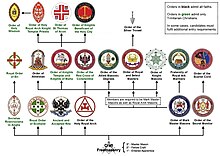Order of Royal and Select Masters
| Part of a series on |
| Freemasonry |
|---|
 |
The Order of Royal and Select Masters is an appendant order of Freemasonry and frequently referred to as 'Cryptic Degrees'. In England and Wales, the degrees are practiced as a stand-alone organisation of Freemasonry while in some other Masonic Constitutions, they form part of the York Rite.
History

The Grand Council of Royal and Select Masters of England and Wales and its Districts and Councils Overseas was formally constituted on 29 July 1873 by four English councils that had been chartered two years earlier by the York Rite Grand Council of New York (see Cryptic Masonry). These four English councils organized themselves as a sovereign body under the leadership of G.R. Portal, a Past Grand Master of the Order of Mark Master Masons, who also became first Grand Master of the Order of Royal and Select Masters.[1] The Order is today administrated from Mark Masons' Hall, London.[2]
Qualification for membership
In England and Wales, all Master Masons who are both Royal Arch and Mark Master Masons are eligible for membership of this Order. Members wear a jewel and a characteristic apron which is triangular in shape.[1]
Structure and organisation
The Order meets in local Councils, each having an elected presiding officer named the Thrice Illustrious Master, who appoints a number of assisting officers. Councils are grouped into districts, each governed by a District Grand Master, who likewise appoints district officers. The Grand Council in London governs around 240 Councils, mostly in England and Wales, but with some overseas. The Grand Council in London controls overseas districts in South Africa, the Caribbean, and the Channel Islands, and also controls a few isolated overseas councils in the Isle of Man and across several nations of western Europe and the Far East.[3]
The Grand Council exercises control of six degrees. The first four are worked by local councils of the Order, and most members will progress through all four degrees. This series of degrees is based on the Masonic legend of King Solomon's Temple and throws light on the links between the degrees of Master Mason, Mark Master Mason, and the Holy Royal Arch.[4][5] They are the degrees of:
- Select Master
- Royal Master
- Most Excellent Master
- Super-Excellent Master
The two additional degrees are granted more sparingly to those who have a history of long or distinguished service to the Order. They are worked only in certain Councils, licensed for that purpose by the Grand Master. They are the degrees of:
- Thrice Illustrious Master (commonly known as the Order of the Silver Trowel)[4]
- Excellent Master (also known as passing the veils)[6]
The degree of Thrice Illustrious Master (Silver Trowel) should not be confused with the title of the presiding officer of a Council, which is "Illustrious Master", but otherwise unconnected.
References
- ^ a b Keith B. Jackson, Beyond the Craft, 6th Edition, Lewis Masonic 2012 (ISBN 978-0853184058), p. 41
- ^ "Index of /". glmmm.org. Archived from the original on 7 August 2020. Retrieved 6 June 2022.
- ^ The Grand Council of Royal & Select Masters, Report of Proceedings and Year Book, 2014 edition. ISBN 978 0 85318 498 0. Published by Ian Allan Publishing Ltd, Hersham, 2014.
- ^ a b Ceremonies of the Order of Royal And Select Masters, accessed 4 July 2015
- ^ The Order of Royal and Select Masters Archived 2016-03-04 at the Wayback Machine, accessed 4 July 2015
- ^ District Grand Council of Somerset & Wiltshire, The Excellent Master Degree
